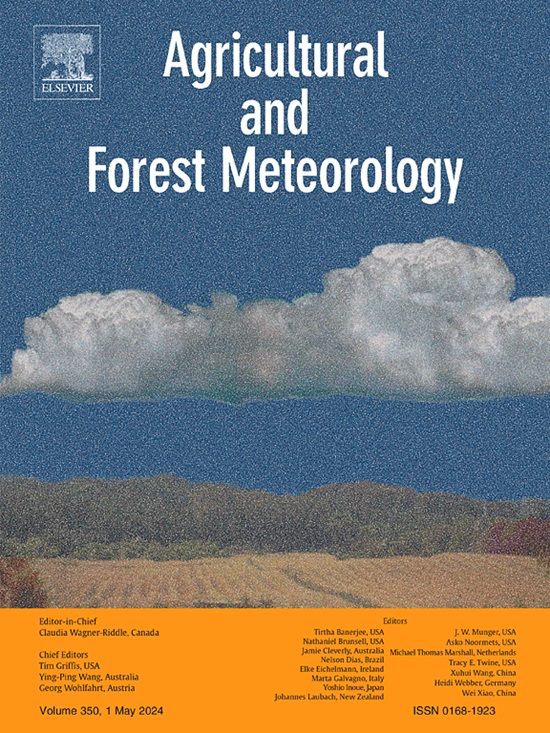陆地蒸散量未来变化的归因:气候变化、二氧化碳上升和土地利用变化的综合影响
IF 5.7
1区 农林科学
Q1 AGRONOMY
引用次数: 0
摘要
蒸散发(ET)是生态水文过程的一个重要组成部分,可受到环境驱动因素的显著影响,包括气候变率、CO2浓度升高和人为引起的土地利用/土地覆盖变化(LULCC)。然而,在未来全球变化的背景下,这些驱动因素形成陆地ET的机制和具体的定量贡献仍然高度不确定。本文首次采用基于过程的地表模型和土地利用模拟模型相结合的综合建模框架,对不同共享社会经济路径和代表性浓度路径(SSP-RCP)下全球陆地ET的未来变化进行了综合估计和归因。在三个ssp - rcp下,预计2020 - 2100年陆地ET增加0.17 ~ 0.60 mm yr - 2。具体而言,气候变化和CO2抑制效应分别对这一增长产生了主要影响(78.14% ~ 78.37%)和次要影响(17.99% ~ 21.44%)。LULCC对陆地ET变化的影响相对较小(0.19% ~ 3.88%),占全球陆地面积的0.64% ~ 4.74%。在南美洲等热带地区,在中等发展情景下,LULCC可占ET变化的17.77% (SSP2-4.5)。我们的研究增强了气候变化、大气CO2浓度上升和LULCC对未来陆地ET的综合和个别影响的认识,并强调了区域尺度上LULCC的重要作用。本文章由计算机程序翻译,如有差异,请以英文原文为准。
Attributing future changes in terrestrial evapotranspiration: The combined impacts of climate change, rising CO2, and land use change
Evapotranspiration (ET) is a crucial component of ecohydrological processes that can be significantly influenced by environmental drivers, including climate variability, elevating CO2 concentration, and human-induced land use/land cover changes (LULCC). However, the mechanism and specific quantitative contributions of these drivers in shaping terrestrial ET remain highly uncertain within the context of future global changes. Here, we employed an integrated modeling framework that combines a process-based land surface model and a land use simulation model to comprehensively estimate and attribute future changes in global terrestrial ET for different Shared Socioeconomic Pathways and Representative Concentration Pathways (SSP-RCP) for the first time. We projected an increase in terrestrial ET of 0.17 to 0.60 mm yr−2 from 2020 to 2100 under three SSP-RCPs. Specifically, climate change and CO2 suppression effects exert primary (78.14 % – 78.37 %) and secondary (17.99 % – 21.44 %) influences on this increase, respectively. LULCC has a relatively minor impact on terrestrial ET variations (0.19 % to 3.88 %), and dominates ET across 0.64 % to 4.74 % of the global land area. In tropical regions like South America, LULCC can account for up to 17.77 % of ET changes under a medium development scenario (SSP2–4.5). Our study enhances the comprehension of combined and individual impacts of climate change, rising atmospheric CO2 concentration, and LULCC on future terrestrial ET, and underscores the crucial role of LULCC at regional scales.
求助全文
通过发布文献求助,成功后即可免费获取论文全文。
去求助
来源期刊
CiteScore
10.30
自引率
9.70%
发文量
415
审稿时长
69 days
期刊介绍:
Agricultural and Forest Meteorology is an international journal for the publication of original articles and reviews on the inter-relationship between meteorology, agriculture, forestry, and natural ecosystems. Emphasis is on basic and applied scientific research relevant to practical problems in the field of plant and soil sciences, ecology and biogeochemistry as affected by weather as well as climate variability and change. Theoretical models should be tested against experimental data. Articles must appeal to an international audience. Special issues devoted to single topics are also published.
Typical topics include canopy micrometeorology (e.g. canopy radiation transfer, turbulence near the ground, evapotranspiration, energy balance, fluxes of trace gases), micrometeorological instrumentation (e.g., sensors for trace gases, flux measurement instruments, radiation measurement techniques), aerobiology (e.g. the dispersion of pollen, spores, insects and pesticides), biometeorology (e.g. the effect of weather and climate on plant distribution, crop yield, water-use efficiency, and plant phenology), forest-fire/weather interactions, and feedbacks from vegetation to weather and the climate system.

 求助内容:
求助内容: 应助结果提醒方式:
应助结果提醒方式:


